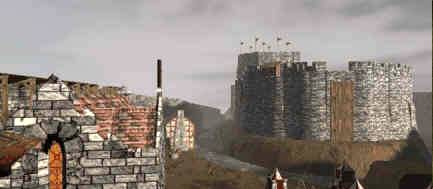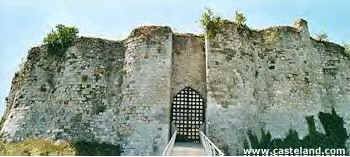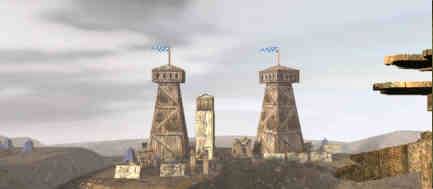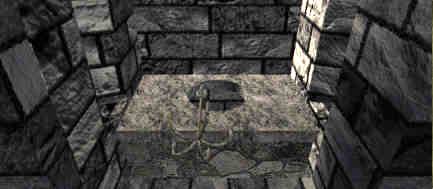Military History in Gaming: Chateau Gaillard
The unique design for the main inner bailey was what set Chateau Gaillard apart from other castles of this era. Its outer wall incorporated the same design features as the outer wall of the castle. Richard also had dirt packed around the outside base of the bailey wall. Rocks and boulders dropped from the top of the bailey wall would hit the packed dirt and fan out, striking targets in a much wider area. Lastly, there was only one entrance/exit here, a solid wooden drawbridge almost as strong as the wall.

Another game screenshot of main bailey.

Present day photo of main bailey.
This could have been the final battle between Richard and Philip, if not for Richard’s death. It would have been very interesting to see Richard defending the castle, to see if his designs truly worked. However, with Richard gone, the defense of the castle was left to Roger de Lacy, one of Richard’s most faithful barons.
{default}Philip had learned a few things about warfare of his own, which he employed during his siege. Philip surrounded the castle blockade-style with about 14 siege machines, and conducted a series of raids designed to find a weakness in the castle defenses. The blockade kept de Lacy from receiving supplies, and stopped any communications from reaching King John. The siege machines pounded the castle wall with huge rocks; if a weakness couldn’t be found, one would be made.

Game screenshot of how Philip’s offense might have looked.
However, it was the raids that proved the most successful. They found out they could sneak into the castle by climbing up the garderobe, the latrine used by the English soldiers defending the castle wall. Once the French army was inside, Philip utilized his engineers to conduct sapping operations on the inner bailey wall. Roger de Lacy was only able to hold out for six months. Chateau Gaillard fell to Philip Augustus on 6 March 1204, and Philip went on to run the remaining English out of France. Chateau Gaillard remained until about 400 years later, when Henry IV ordered it destroyed in 1603, after it held out against a siege that lasted two years.

Game screenshot of the French infiltration into Chateau Gaillard.
As mentioned before, this is by no means a complete historical telling of all subjects herein. Nor is it meant as a review of the game. Rather, it was merely written to show the ?edutainment’ level of The Journeyman Project: Buried In Time. Look around the local bargain bins or your favorite online shopping store for the game, and see first-hand what I mean. There are many more games available that deal with military history this way, and in better ways, and it is my hope that I have intrigued you enough to seek these out.
Sources
The Journeyman Project: Buried in Time PC game
developer, Presto Studios
Publisher, Sanctuary Woods, Inc.
The New Advent Encyclopedia
Photos used by permission from Castleland
>
Stay Alert, Stay Alive!
Jim H. Moreno

This work is licensed under a Creative Commons Attribution-NonCommercial-ShareAlike 2.5 License.


Awesome article! Thanks for giving such a thorough and interesting insight into the history of gaming and gaming history! Keep up the great stuff, this is exactly why I keep coming back to Armchair General!